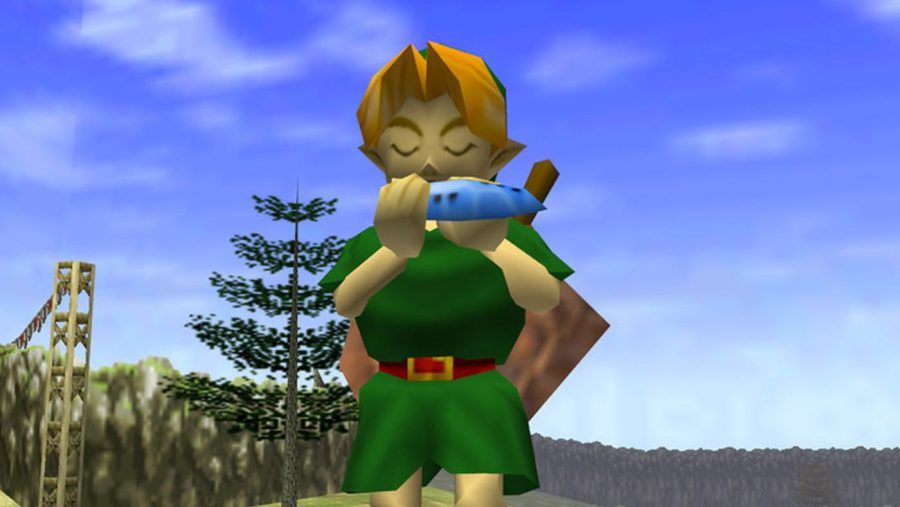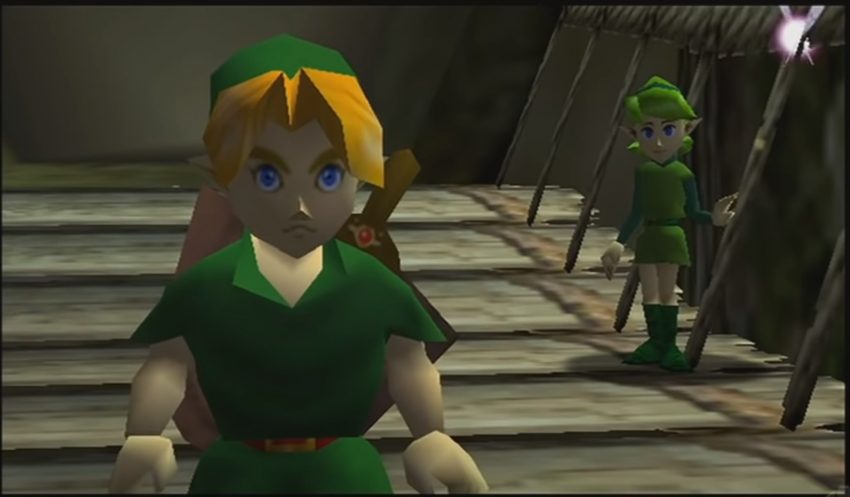Appreciating How The Sounds of Zelda Make Us Feel
Posted on December 12 2020 by Andrew Millard

The longest running alert sound on my phone is from Ocarina of Time. You know the one: It’s the jingle of overstock notes you hear when picking up an extra bundle of arrows or your millionth Deku stick. Boodle-oo-bop! I hum the treasure chest chime whenever I snag the last soda from the fridge. When I playfight with my kids, I do my best Link-style shouts. And it’s all because of the perfection of Zelda games’ sound design. Little chirps, beeps, and bundles of music notes that can boost your pride or put you in your place. I realized some time ago how Zelda’s soundscape persists in my imagination, and is now tied to not only the unique distress gaming can put you in, but also simple, joyous moments in real life.
Video games as a craft need to take care how they telegraph information to the player, particularly when rewarding them. Think of landing three hits with a dragon punch in Street Fighter, or nailing a riposte in a Souls game. Combat-heavy games will often apply a touch of time dilation to let those moments sink in all the better. In Breath of The Wild, Nintendo uses that slowdown effect and does one better, adding the reverb and echo of each clash you land during a Flurry Rush. It slaps your adrenal gland awake and makes you feel like that Lynel is out of his league. But compelling games will juggle other emotional states. They encourage us to take on the stress of risk to better enjoy the euphoria of reward. They invite us to be sad or relieved. To do all this, The Legend of Zelda’s sound designers have found an expressway through our ears and into our emotions. Let’s take a look at this connection in three of the series’ main entries.
A Link to the Past, and The Subconscious
Zelda games tend to be light on combat. And yet, those satisfying bits of battle audio come quick and often. They provide some of the most addictive split seconds in all my time gaming. As I think back to playing A Link to The Past, I can hear perfectly an arrow limply deflect off an Armos’ shield just before the next shot lands with a gratifying phthunk and groan. And why is that? I’ve played that game several times in my life, but unlike a lot of intense memories, I can’t chalk it up adolescence. I didn’t make a complete playthrough of Past until my 20’s. I believe it’s because it set an incredible standard for Zelda games going forward and the adventure genre as a whole. And it has the most gratifying vanquish sound of all games.

Your memory has already soundtracked this scene!
Seth Horowitz, author of The Universal Sense, makes the point that our hearing is an “attentional driver.” Though we tend to experience life primarily through vision, it is our hearing that tells us where to focus. As an auditory neuroscientist, Dr. Horowitz explains that our minds need to tie serious emotion to what we hear so that we assign the source appropriate importance. This puts hearing in a unique position among our senses as it forms a gateway for long-lasting relationships between sound and memory.
The Universal Sense also points out that because hearing has a hotline to our biochemical responses, we must be capable of habituating sound: subconsciously ignoring it or relegating it to ambiance so that our minds are not bombarded. Hearing can alter our emotional state in .0003 of a second. It’s why rain on the roof can make you cozy and nostalgic, while the sudden bark of an unseen dog or rumble of a speeding truck can zap your brain and raise your hackles. It’s why sometimes you want to belt out the chorus of your favorite song, while at others you just want to fall asleep to nature sounds or a running fan. This is also why brilliant games like Zelda can put us on an emotional rollercoaster in a single dungeon.
Back to the sounds of A Link to the Past. For kicking off an adventure, there’s nothing like the preamble to the game’s title screen and fanfare. I measure every game’s startup against it. Edgar Winter even used it to pan down the opening shot of Scott Pilgrim Vs The world. Those notes played in my head automatically whenever I’m about to start something new and exciting. But a sense of new adventure wouldn’t be exciting without at least some minor threat tagging along.
While the original game birthed many sounds still engrained in the series, A Link to The Past solidified their legacy and contains their most iconic versions, including the nerve killers. Few alerts in gaming are as instantly recognizable as the low-hearts beep. Over the series, the alarm has varied in severity, recently doing away with it in favor of exhausted character animations. There was a time, though, when that bee-deep! bee-deep! could drive the player to a panic looking for stray hearts. Perfectly illustrating the hardwired connection between sound, emotion, and action I would go from confident to sloppy play as I forsake all else to stop. That. Sound!
Ocarina of Time Linked Sound with Emotion
Any conversation about Ocarina‘s place in the series will touch on how it brought the Zelda recipe fully-realized into the era of 3D gaming. That leap forward included the game world’s sound cues, but you have to listen(!) for it. Ocarina of Time baked music into Zelda gameplay going forward for the series. However, notice that the sounds of Kokiri forest are all you get as Saria bids Link farewell. In a game that revolves around music, not to mention the very instrument of Saria’s gift, sound designers Yoji Inagaki and Yakuya Maekawa were allowed to let the environment breathe around the two parting friends. That scene could have just as easily been scored with a schmaltzy theme. The choice to let the forest do the talking speaks volumes.

A scene with no BGM in a game about powerful music.
Another upgrade in audio came with Link’s Charged Spin Attack. The 16-bit era has aged best among generations, but Ocarina‘s sound kit perfected Link’s signature attack. It could only be tinkered with in future games. Steely and organic with a subtle stereo fade, the sword charge has never been more satisfying. The only worthwhile upgrade to it came from the much-maligned Skyward Sword. I loved to hear a full Skyward Strike pump out the tinny little speaker in my Wiimote. Controller-based audio cues can be a gimmicky trick, but that one example is more memorable to me than any I can think of coming out of my Dualshock.
Ocarina of Time‘s incidental sound events can quicken the pulse or tug at your heartstrings as well. Those sweet little cucoo clucks can switch in an instant to a mob’s battle cry against animal cruelty. One I would think of often as I tended to my backyard chickens. Then there is the bone-chilling gaze of a redead that suddenly turns the game into survival horror. Fans have long discussed the latent dread in the Zelda franchise. That vibe was born in Ocarina‘s washed out, apocalyptic world.

Can you even remember what a Resident Evil zombie sounds like?
Academic musician Lawrence English writes that it is actually much easier to frighten an audience with sound than sight.
[It’s] our ears, not eyes, [that] revealed what lay beyond the light of the campfire. And importantly, our ears helped us recognise what lay behind us, out of sight. Sound has the profound ability to haunt, shock and terrify. It has a primordial quality that reaches deep inside us.
Much as a skilled horror novelist will use suggestive description instead of gory detail to let the reader’s imagination do the heavy lifting. Ocarina of Time does this with style in something so simple as centering the camera. Have you noticed that in the overworld the Z button makes a whimsical glissando, while in dungeons it’s an ominous breath? Moldy gurgles, distant crows, and lonesome wolves nurtured the fertile creepypasta soil that would surface Majora’s Mask.
The Background is Foreground in Breath of The Wild
Most recently, the ambiance of Breath of The Wild has tunneled through my ear and into the bloodstream. It’s to the point where, if I’m out on a hike, I half expect to hear the telltale tambourine jangle of a nearby Korok. Even the quietest moments of the game give me a little buzz: the sound of the glider plumping up in an updraft, or the retro-futuristic ping of a nearby tower.
A game series long-famed for it’s music relegates the soundtrack to a minimal piano score. Where sound design was a two-person team for A Link to the Past, Breath of The Wild had a credited team of 16! Can it be labeled ambiance when the game’s atmosphere is meant to be the focus?

Golden Hour in Hyrule sounds like bliss.
More has been written about Breath of The Wild‘s sound design than that of all previous games combined. And with good reason! Choice is abundant on YouTube if you just want to sit in the sounds of Hyrule. All those times Shigeru Miyamoto recounted how Zelda sprung from his days spent exploring backyards and country sides crystalized in Breath‘s sonic landscape. He wanted games to be a singular experience, to spark discovery in the player. Not to be pretentious, but it’s tempting to compare that goal to Zen Satori, a sudden of moment of true clarity. Famed Buddhist writers like Wumen and Ikkyu connected their Satori to common sounds of nature: A clap of thunder for the former, and a crow’s call for the latter. In a world where so many of us are forced to live at a remove from nature, why not find a connection to it in digital lands?
Gaming will forever be seen as an indoor hobby. But through The Legend of Zelda, it has ironically enhanced the simple pleasures of my life outside, at home, and with family.
Which parts of the series’ audio design have stuck with you? Leave a comment to tell us where your favorite Zelda sounds crop up in real life.
Andrew Millard is an ELA teacher in the Upper Midwest. He has been playing Zelda games since 1990.
Special recognition to HTW and Dayjo at Zelda Sounds

Andrew is a writing teacher in the American Upper Midwest. He has been playing Zelda games since 1990.



